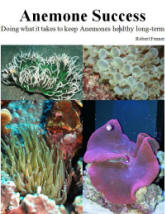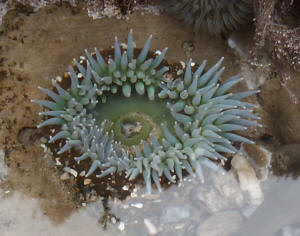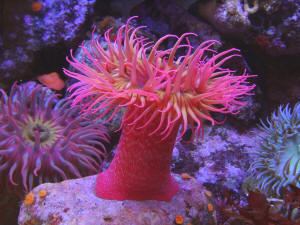 |
New Print and
eBook on Amazon:
Anemone Success
Doing what it takes to keep Anemones healthy long-term
by Robert (Bob) Fenner
|
Keeping E. Pacific (coldwater) anemones; system
4/25/20
Hi Mr. Fenner,
<Jonah>
I have listened to a couple of your talks and used your website. I have
found all the information you put out extremely interesting.
<Ahh>
I am attempting a cold water pacific-coast setup with anemones.
<Oh!>
I was wondering if you have any advice as to the care requirements of
Anthopleura sola, A. elegantissima, or anemones the Urticina genus.
<I know a little; have kept the local anemones, studied the elegant
clone in college... histologically; have friends who are coldwater
keepers, and volunteered years back at the local public aquarium where
we kept
Metridium, Tealia... species>
I don't have a separate system to exchange water with to allow new
additions to slowly get to know one another as you have suggested.
<Mmm; okay. Do need a chiller>
I'm trying to run a lot of carbon and to match their environment in
terms of temperature and flow.
Are there any specific things that you would recommend I try?
<Well, need to know a bit more re your set up... size, gear make up...
Do tell>
Thanks very much,
Jonah
<Glad to share. Bob Fenner>
Re: E. Pacific Anemones husbandry 4/26/20
My total water volumes consists of a 35 gallon display aquarium with 1"
acrylic on all the sides and bottom.
<Good for insulation>
I have a good 1/10hp chiller and haven't had any issues maintaining
55.5-56 degrees F, which is currently
my target temperature.
<I'd let this up during the summer/warmer months... high 50's, low 60's>
In addition to the anemones I have many macroalgae and so I have strong
lighting optimized for plant growth, though I've considered switching to
bluer light for aesthetic purposes.
<... the strength of lighting is a relative term... 40-50 PAR, PUR for 8
hours a day is fine>
Plenty of flow between return pump, chiller pump, and two DC Tunze
powerheads. Plenty of bio media. I am planning on drilling the aquarium
and adding a sump to increase water volume.
<Ah, good>
My ph has stayed fairly low around 7.6-7.8- I think the chert rock and
sand (common in my area) contributes to this.
<I'd be adding a commercial supplement here. SeaChem Stability is a
fave>
Nitrates and phosphates have stayed high, especially phosphates
(0.4mg/l, nitrates around 25mg/l).
<Not a worry>
From my discussions with other keepers of coldwater aquaria, these
slightly elevated numbers are not uncommon but I would still like to get
them down. When I add the sump I'll have a lot of options there, so I am
not too concerned.
<Good... DSB there, RDP... BobF>
Blue Spotted Puffer Fish and... Really: Beadlet
Anemone (Actina equina... coldwater)
3/2/10
Hi,
We have a 180 litre Aqua One Regency marine tank in which we keep a
Blue Spotted Puffer Fish, two Common Clown Fish, a Blenny and A Yellow
Sailfin Tang.
Recently we ordered some Beadlet Anemone (Actina equina) from a chap on
eBay which we are expecting to take delivery of next week.
<You do realise this is a coldwater anemone? It isn't going to
do well in a tropical aquarium. Have kept this species many, many times
and it is extremely hardy. For a while it will do okay in warm water.
But what seems to happen is that its life cycle speeds up dramatically,
and you eventually end up with thousands of tiny anemones and hardly
any adults (it's a livebearer, and breeds about as quickly as
Aiptasia, given the chance). As a student I kept some in a tropical
aquarium with mantis shrimps, and this is what happened. They
didn't die out to be sure, but they were more of a best than a
blessing. By contrast, when we kept them in room temperature native
marine community tanks, they did extremely well and provided lots of
colour.>
The seller assured us that there would be no problem keeping the
anemone with the fish we have, however we have seen on your web site
that one nip of an anemone by a Puffer Fish is most likely to be
fatal.
<Unfortunately there is much (deliberate?) ignorance on eBay and the
like, with people selling Beadlets as cheap tropical anemones and even
brackish water anemones. Like most intertidal anemones they will (a)
tolerate
elevated temperatures for a while and (b) tolerate reduced salinities
for a while but neither of these facts makes them either true tropical
anemones or brackish water anemones. A further complication is that the
species
Actinia equina is probably a species group, so while there certainly
are specimens occurring as far south as West Africa, it's unknown
whether the ones you find around the UK coast, for example, are
genetically the same thing. Since the people selling them on eBay are
almost certainly getting them from places like the UK rather than West
Africa, what you're buying are the coldwater sort.>
The information regarding the anemone states that when threatened
its' tentacles retract and so we were wondering if they will be
safe after all?
<When stressed, the tentacles do retract. Typically they do this
when above the waterline, when the tide is out. But in tropical tanks
they do this a lot underwater too, suggesting they don't really
like tropical conditions.>
Although I have had tropical fish in the past and indeed still do both
of us are new to the world of marine fish keeping so any information
regarding this would be most welcome.
<I fear this was a mistaken purchase. The problem with Beadlets is
they're sold very cheaply, often for just 1 UK Pound, less than 2
US Dollars, so folks think they're getting a bargain. They are not.
These are coldwater anemones for native marine aquaria, where they get
along quite well with all the usual gobies, blennies and shrimps.
They're easy to feed, and while they do have stings, most of the
usual marine life kept with them manages to avoid blundering into them.
Just feed them weekly with small morsels of fish, shrimp and mussel.
Will starve to death quickly if not fed regularly, since they lack
zooxanthellae.>
Regards,
Darill and Tracey.
<Cheers, Neale.>
Re: Blue Spotted Puffer Fish and Beadlet Anemone, coldwater
anem. -- 3/3/10
Cheers Neale,
Thank you for your speedy and very informative response :o)
<My pleasure.>
We have found your website to be extremely helpful during the last few
weeks (since purchasing our marine set up) and although completely new
to aquariums we are keen to both learn about, and enjoy our fascinating
new hobby.
<Cool.>
Laff though - please excuse our ignorance I never even thought about
them being cold water, I guess its best not to put them in our tank
then - dont quite know what to do with them now when they arrive
:o(
<Indeed, a problem. A coldwater tank 5-10 gallons in size with a few
rocks, these anemones, and some of those live river shrimp they sell in
UK pet stores could be kind of fun. Water changes would be easy: just
replace old
water in the coldwater tank with some from the marine aquaria, though
best to let that water cool down to room temperature would be wise.
Such coldwater tanks are very, very easy to maintain, and you might
even bring
back some beasties from your next holiday. The Glaucus site has some
nice stuff on UK marine fish fishkeeping, here:
http://www.glaucus.org.uk/wetthumb.htm
>
Kind regards
Tracey and Darill
<Cheers, Neale.>
Cold water anemones 7/21/09
Bob,
<Kim>
In an email from David(?) many years ago, he asked you about some cold
water anemones he saw in a elementary classroom in Las Vegas. He said
the teacher referred to them a large aggregating anemones and
commented that this was "vague". I am the teacher to whom he
was referring. You told him they may be Anthopleura xanthogrammica.
Since David's visit, all my anemones have died--the last three died
just last year. I still have the tank set up just as it was and am
looking to replace those anemones. When I came to the school, I was
told they were collected off the coast of Oregon. I would like to know
if you are familiar with anyone who I may get in touch with that could
possibly help me get more of these anemones for my tank?
<Have just checked Carolina Biol. Supply on line... and a generic
search for the species... You might try a college with a bio. program
on the coast>
Also, I'm still not sure exactly what kind they were. I would
appreciate any help you could give.
<Perhaps the above, or A. elegantissima>
Just a little background on my classroom--It is in an elementary
school. We have eight large saltwater tanks
including a shark tank, a coral reef tank and a tide pool. Each house
organisms representing the various ocean habitats. The cold-water tank
is the oldest, but unfortunately it's the empty one. Help?
Thanks, Kim
<Good hunting! Bob Fenner>
|
Anemone ID, and a note re the death
biz 4/11/09
Hello,
<Howsit?>
Just a quick question. I recently got stationed at Vandenberg AFB
on the central coast of California. There are a few beaches that
are actually on the base and while exploring one of them at low
tide i happened to stumble upon about a thousand or more of these
anemones. Sorry about the quality of the pic it was taken with my
blackberry. I never thought that such cold water would hold such
a variety of different colored anemones. There were green,
orange, blue, purple, red, and others that i cant remember right
now. Anyway to the question what type of anemone are these and
would it be possible to keep them in a central California coast
themed tank?
<Is... and are Anthopleura xanthogrammica... The
"giant" (larger with ecoclinal variation toward the
north) "California" (except when elsewhere) Green Sea
Anemone>
Not that I'm actually thinking of removing them straight from
the ocean just curious.
Thanks,
Kris
<Watch that curiosity... Bureaucracies like the military
destroy such that leads to innovation... makes the folks at the
top look inept (they are), and who wants to appear inept. Cheers,
Bob Fenner>
|
 |
Crown of Thorns Seastar, and coldwater anemone species
searching... 5/19/07
Hi Bob, Please
tell me where I can buy some Crown of Thorns Seastars. <For...
research?> I would also like to buy some Frilled Anemones (Metridium
senile). Where can I find these? <Have your dealer contact Quality
Marine in Los Angeles re. Bob Fenner>
Thanks,
Marc Chatham
Cold marine tank question- anenomes and lighting - 03/18/07
Dear WWM denizens, <Of the deep?> I've enjoyed your FAQs
quite a bit, but am finding it tricky to find information on setting up
a cold marine tank. <We don't have much... yet. Do a search
about for the written works of Dave Wrobel here...> I
have found the wonderful people at coldwaterfish (a yahoo group) and
the occasional lurker on saltwaterfish.com knows something about cold
marine tanks, but still am encountering difficulties. <Okay...> I
have a 1/6 hp chiller, protein skimmer, and powerhead, in my 29 gallon
tank. I'm writing today to ask you about
anenomes. My tank is going to be a sea star dominated tank-
<It's kind of small...> I'll have 1 bat star and probably
two ochre stars, <Patiria and Pisaster? Know them well...> but
I'd also like to have a couple of anenomes. No (or maybe
1) fish, a couple of hermits, a couple of snails, that's it.
<Mmm, again... wish this tank were bigger> Does anyone on WWM
know about lighting requirements and Pacific NW anenomes? My initial
research indicates that they need less light than tropical anenomes,
and indeed, that even fluorescent lighting would be sufficient for a
couple of small anenomes. <Do need some of the same requirements...
of temp., CRI as other Actinarians from the tropics... not as much
intensity...> Your response is most appreciated. Thanks
again for being there on the web. Rachel <Please read here: http://www.wetwebmedia.com/marine/inverts/index.htm Scroll
down to the Anemone tray, the bits on lighting... And do consider
penning an article or twenty on this field! Bob Fenner>
| Coldwater Anemone pic by Chris
Schmidt 8/4/06 It is a white spotted rose anemone
in the front and a painted anemone in the back left. Temperate Salt
water tank. <Mmm, yep... these are Tealia lofotensis, found off
the coast of California and northward... Thanks for sending along.
BobF> |
|

|
| Very good, I see you know your stuff. I actually no
longer have the tank set up, due to the cost of electricity.
Keeping the water 52 degrees was expensive. <Ahh... thank you
Enron, former <and current> crooks and incompetents in the CA
et al. States gov'ts...> Was fun though and I fun though
considering it is an extremely rare find. Only those with
Scientific Collecting permits, or extremely unusual circumstances
have such the luxury... Take Care, Chris S. <Thank you again.
Will share. BobF> |
More with temperate water anemones... Dear Kevin, Thank you
for your reply. In the meantime we purchased coral lighting
and placed it over the tank along with a regular bulb. <I assume
that your store suggested simply adding a blue actinic lamp to the
setup. If that was the case it's still in trouble. I hope this
lighting was at least power compact fluorescents.> We feed it
tropical fish food flakes. <I apologize for not recommending it a
food. You can feed it pieces of fresh shrimp, or one of the many frozen
meaty seafoods available at your local fish store.> For two days it
was splendid, now it is shriveling up and has white stuff dangling from
it. <It is likely dying.> I believe it is on its last
breath. Was it the wrong food? <Likely, unless it was
marine flake> I may want to replace this with a store bought Anenome
before my daughter gets home from camp. <Please don't!!!>
There may have been too many changes while we figured out what was
going on. <It is dying because it's not in the right
environment. It's sort of like bringing a penguin to the jungle,
feeding it bananas, and expecting it to live.> Still, if
there is a way to save it, that would be fantastic. We were
advised to put the temp up to 76 degrees <I'm assuming that
you've researched what the water temperature where it's found
is at and this is not a recommendation from your local fish store. This
anemone cannot be treated as a Caribbean anemone.> , the salinity
and chemistry was supposedly perfect. If I replace this, is
there an Anenome that is easy to keep. <Caribbean Condylactis
anemones are very easy to keep provided with lighting of adequate
intensity. Please let me know the brand, wattage, and color of the
"reef lighting" that you bought so I can make further
recommendations. -Kevin>
Actinia tenebrosa anemone 3/3/03 Hi, I am interested in a
Australian waratah anemone. Can you tell me anything about
them. <Yikes... it is intertidal and cool tropical to
temperate! If you live in the USA, you are very unlikely to get it and
will need a specialized tidal display tank with a chiller at any rate.
This is not a tropical community species by any definition> I have
some reef fish gobies and such along with Long tentacle anemone, polyps
and leathers. Will they bother any tank
mates? Thanks for your time Jbug <good heavens, no my
friend. Not only will it not mix with your tropical species... but
mixing two or more anemones is dangerous. Not at all sensible. It is
already unnatural enough to mix most any anemone like your long
tentacle in a reef aquarium with corals. Few are actually found on the
reef with stony corals and all will fight when mixed in time (takes
months or a couple years for the slow poisoning to effect some). If you
do acquire a waratah anemone, please know that it needs bright light...
likely metal halide will be necessary. Anthony>
Cold Pacific Coast Anemones Bob...I have recently encountered
a new kind of anemone that I can't find a scientific name for.
These 6 anemones have been housed at an elementary school in Las Vegas
for more than 10 years! The anemones are of the cold water variety
(temp is constant at 58F), were caught off the coast of Oregon, and are
gorgeous colors: mint green, and hot pink. The lighting is very
low. They are also quite large and have been
spawning/reproducing regularly. If needed, I will try to get a
snapshot. The teacher refers to these critters as "large,
aggregating anemones." How's that for vague? Any ideas or
places where I could find such information? Thanks. David <Pink? If
it weren't for the color I'd say Anthopleura xanthogrammica
(the large green anemone)... but maybe a Metridium or Italia species.
Use your search engines with these genera. Bob Fenner>
Anemone (id, California coast, husbandry) Hello, In the tide
pools by La Jolla I noticed a large amount of anemones (looked like
?rock anemones?). Could you identify this type of anemone for me?
<Yes, these are Giant Green Anemones, Anthopleura
xanthogrammica (much more "giant" as you go north up the
coast to Washington...> What does it eat (I suspect crustaceans ?
but what type and what size per size of anemone crown when opened, e.g.
a two in long crustacean for a four inch in diameter crown)?
<They're photosynthetic (notice the whitish ones that are more
in the shade, as well as "meaty" eaters... fish,
invertebrates, most anything they can/do get their tentacles on. Put
the common and scientific name in your search engines to learn much
more. Bob Fenner> Thanks,
Kevin

